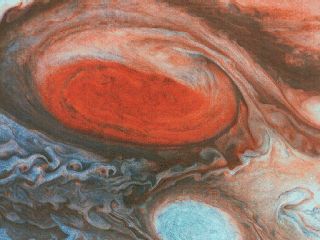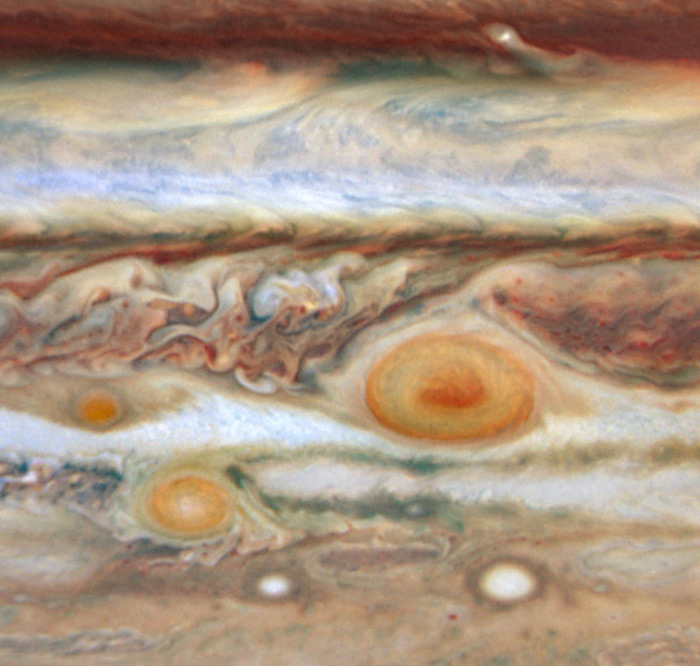"Galileo" helps to explain the intense storms on the surface of Jupiter

The weather on Jupiter, the largest planet in the solar system, always seems to be stormy. Lightning flashes deep within the gas clouds that envelop it, huge eddies move throughout the atmosphere, rain clouds rise to a height of 50 km above the low cloud layers of the planet. Now new observations reveal that warm, moist flow rising in the storm currents likely provides the energy that drives the weather on Jupiter's surface.
Scientists analyzing images taken by the Galileo spacecraft orbiting Jupiter have concluded that this moist heat flow of storms on the surface of Jupiter is similar to that on Earth (albeit stronger), but is generated by heat from a completely different source: from deep within the planet , and not from the sun's radiation.
A team of astronomers led by Dr. Peter Girash of Cornell University found the most significant evidence in images of the southern equatorial belt, west of Jupiter's Great Red Spot - the same spot that appears as a permanent storm in the southern hemisphere.
Pre-dawn lightning could be seen in the pictures. Then, a cluster of giant storms similar to those on Earth developed there. The scientists estimated that the vertical transport of heat by such storms corresponds to the flow created by the internal heat source of the planet. "Therefore, we conclude that the convection of vapors is a dominant factor in turning the heat currents into the energy responsible for the movement of gases in Jupiter's atmosphere," Dr. Jiras' group wrote.
In another report, a group led by Dr. Andrew Ingersoll of the California Institute of Technology in Pasadena argued that the lightning that precedes storms is significant evidence of the presence of large amounts of water in the low clouds. Nothing else, we noted, can condense at a height of up to about 100 km below the upper atmosphere.
"That's why we can use lightning as a kind of beacon, pointing to where there are raindrops that fall quickly and air columns that rise quickly and are a source of energy for eddies," said Dr. Ingersoll. "The vertical eddies, in turn, are broken up by horizontal currents and transfer their energy to other climate zones on the surface of the planet. So in the end, the giant red spot gets its energy and stays alive by 'eating' these eddies."
On Earth, violent storms like hurricanes and cyclones are fueled by ocean heat. The water is heated by the sun, which affects all weather on Earth. But Jupiter is five times farther from the Sun than Earth, and the intensity of the Sun there is only 4% that on Earth - not enough to cause the observed storms.
Scientists have long assumed that Jupiter's internal heat somehow stirs the thick layer of the atmosphere. Due to the heat reservoir of the highly compressed hydrogen in its center, the planet produces almost 70% more heat than it receives from the sun. Vapor convection has already been proposed in the past as the mechanism responsible for the rise of heat from the depths of the planet, which drives the weather on its surface. The new study shows that such a fever does occur.
New York Times
{Appeared in Haaretz newspaper, 23/2/2000{
Storms merge in Jupiter
A rare astronomical phenomenon was observed for the first time on the planet "Jupiter"

For the first time, astronomers witnessed the collision and merger of two giant storms on the planet Jupiter. This is what scientists from the Jet Propulsion Laboratories at NASA said on Monday. "Normally, when we saw two storms approaching each other, they 'jumped' back and moved away from each other, this time they merged," said a senior researcher at the laboratory. The discovery could help in investigating the nature of the atmosphere of the planet Jupiter, and in understanding its famous red spot, which is itself a giant storm.
It is possible that a similar merger of storms occurred hundreds of years ago, and is the one that created the star's red spot - a storm that is twice the size of Earth, and has been moving in the southern hemisphere of the star for over 300 years.
The current giant storm began 60 years ago when three "white oval" storms began to form south of the red spot, each about half the size of the Earth. Until 1998, the storms sometimes approached each other, but never collided. At the beginning of 1998, while Jupiter was moving in its orbit towards the backside of the Sun and out of sight of the Earth, two of the storms began to approach each other. When the star was rediscovered one large storm was seen, instead of two storms. The occurrence of this merger could not be seen by the scientists, but last fall the new big storm approached, in the direction of the third "white" storm.
The collision between them began in March 2000 and lasted for three weeks, before the eyes of the astronomers. The approach and merger were observed at several wavelengths and showed different depths using several telescopes.
